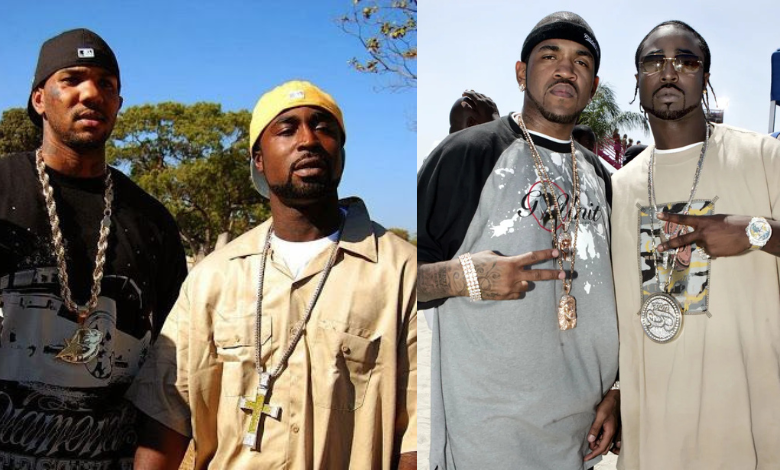Young Buck & 50 Cent: From Brotherhood to Beef — The Untold Story

Let me tell you a story I often come back to when thinking about rap drama, loyalty, and image. It’s about Young Buck and 50 Cent — two names that, at one time, seemed inseparable, but whose relationship turned into one of hip hop’s more tangled sagas.
If you’re curious how two artists can go from brotherhood to feuding, and maybe back again, this story has it all: music, business, betrayal, revival. In this article, we’re going to explore their backgrounds, how Buck joined G-Unit, what tore them apart, and where things stand now. I’ll also share what I think really happened behind the scenes.
1. Backgrounds & Early Career
Young Buck: The Southern Firebrand
David Darnell Brown, better known as Young Buck, emerged from Nashville, Tennessee. From early on, he had grit — a mix of southern street soul and raw storytelling that stood out in a scene dominated by East Coast / West Coast names. He had that grounded authenticity: scars, survival, ambition.
When he first came into view, he was already independent, hustling, making local buzz, putting out mixtapes. That raw energy made him appealing to bigger labels and eventually to G-Unit, which was searching to broaden its sound and reach.
50 Cent: From Survival to Empire
Curtis Jackson, aka 50 Cent, had a meteoric rise. Surviving gunshots, navigating tough streets, and possessing undeniable charisma and business instinct helped him build a brand beyond music — from G-Unit Records to film, TV, and entrepreneurship.
By the time Buck came into the picture, 50 Cent had already proven he could survive and thrive under pressure. That made him both a magnet and a test for any artist wanting to work with him.
Read Also: Carle Classic: A Deep Dive into the Eric Carle Classic Collection
The Meeting Point: G-Unit & the Appeal to Buck
G-Unit was more than a label — it was a crew, a brand, a movement. The name meant loyalty, street credibility, unity, loyalty to 50 as the leader. For Young Buck, joining G-Unit represented a chance not just for fame, but for legitimacy. For 50, bringing Buck in meant adding southern presence and fresh energy.
Buck formally released his debut under G-Unit / Interscope with Straight Outta Cashville in 2004, which symbolically references his hometown and nods to the classic Straight Outta Compton model. The album did well, debuting high on Billboard charts, partly thanks to the backing of G-Unit’s infrastructure, marketing, and collaboration.
One of their first big collaborations was “Let Me In,” Buck’s debut single which features 50 Cent. The track’s success showed that together they could expand both of their audiences.
That was the start: synergy, mutual benefit, and high expectations.
2. Peak Collaboration Era
When two artists align well, fans latch on. Buck riding under the G-Unit umbrella meant access to better studios, marketing, features, touring, and co-sign power. Meanwhile, 50 got credibility in the South and street cred reinforcement. Win-win.
They appeared together, exchanged features, and built a narrative of brotherhood. Buck’s image was somewhat softened by the association — not too soft, but more palatable to labels and mainstream listeners while retaining edge.
From 2004 to around 2007, their collaboration was solid. Buck’s Buck the World dropped in 2007. While it didn’t have the same commercial success as some G-Unit flagship releases, it cemented Buck’s place as a solo act with weight.
That period was one of growth and promise. But underneath, tensions were forming.
3. Conflict & Fallout
Here’s where things get messy.
Early Tensions and Warnings
Some say the cracks began when Buck started affiliating with artists or doing deals that 50 didn’t approve of. In interviews, Buck has admitted he sometimes worked with people who had problems with 50 — a line 50 felt shouldn’t be crossed. Also, 50 — as the leader — often expected loyalty above all. That expectation, while normal in a group structure, clashes with artists’ desire for independence and personal moves. Over time, those tensions boiled.
The Public Break & Booting
In 2008, in a moment that shocked many fans, 50 Cent publicly booted Buck out of G-Unit during an appearance on Hot 97. That moment reshaped their relationship forever.
Soon after, 50 released recorded conversations in which Buck is emotional, apologetic, seemingly begging to stay. The public got a narrative: Buck had failed, 50 was the harsh but fair captain. Some of Buck’s supporters accused 50 of humiliating him for image, clout, or control.
From there, diss tracks, trolling, public statements, social media jabs — the feud escalated.
Examples of Trolling & Attacks
In 2019, 50 Cent mocked Buck over a supposed relationship with a transgender person, writing things like “that’s a boy, Boy” on Instagram, and suggesting that this would confuse Buck’s audience. Buck fired back, challenging the narrative and accusing 50 of trying to manipulate the public’s perception.
At times, the fight looked less about music and more about image, control, and who shapes what the audience believes.
Meanwhile, Buck faced his own problems—financial, legal, personal—that may have weakened his leverage.
4. Buck’s Struggles & Legal Issues
When you dig into Buck’s life during the fallout period, it’s hard not to feel empathy. Fame doesn’t protect you from debt, addiction, or bad decisions.
Financial & Tax Problems
Buck ran into tax issues. He reportedly had unpaid taxes of about $300,000. In a dramatic turn, the IRS raided his home, and authorities discovered an unregistered firearm — which, in Buck’s case (as a convicted felon), became a parole violation.
That led to him being incarcerated for about 18 months. During that time, his public profile weakened. Projects stalled. Deals dried up. The legal system rarely plays fair with artists in those situations.
Buck has spoken candidly about hitting rock bottom: losing his house, losing most of his assets, having to rebuild from nothing.
Impact on His Relationship with 50
While behind bars or dealing with legal strain, Buck could not effectively defend himself or negotiate from a strong position. Any public statements, music releases, or social media moves had less impact when he was constrained.
Also, the narrative 50 had built (of Buck’s failure or betrayal) may have gained more traction. In a feud, the side with more freedom to speak often controls perception.
It’s natural to suspect that Buck’s vulnerabilities made reconciliation harder—or made 50 more confident in maintaining distance.
5. Claims of Reconciliation & “Beef Was Fake”
Sometimes feuds in music are real. Other times, they’re staged, exaggerated, or performative. Buck has at times claimed the latter.
Buck’s Claim: “We’ve played y’all”
In 2021, Buck went live on Instagram and said that the beef was largely for show. He said:
“We ain’t got no muthafuckin’ beef … We done played y’all muthafuckin’ ass.” He claimed he just got off the phone with 50, they shot a video, and were going to drop it.
If true, this suggests both of them may have used the feud as a marketing tool, to stay relevant or maintain attention.
That doesn’t mean everything was fake, though. Emotions, misunderstandings, and real wounds likely existed.
50 Cent’s Side & Ongoing Trolling
50 has continued to troll Buck on social media. Whether that’s genuine, provocative, or a branding move is open to interpretation. The trolling ranges from mocking alleged personal matters to joking about Buck’s career.
In the complex world of celebrity feuds, it’s often hard to tell what’s real, what’s exaggerated, and what’s strategic.
6. Later Years, Comeback Attempts & Legacy
Musical Output After the Rift
After being kicked from G-Unit, Buck continued releasing music. He tried to rebuild his image, staying true to his style: street narratives, raw emotion, and grit. But without G-Unit’s backing, scale, and marketing force, it was always an uphill battle.
His music retained a loyal fanbase, though not the mainstream push he once had.
Reconciliation, Reunion Rumors & Collaborations
Rumors and public statements about reunion have floated for years. Buck claims stuff is in the works. Whether it’s fully sincere is uncertain.
The idea of a G-Unit reunion involving Buck excites fans. It would rewrite parts of the narrative: from betrayal to redemption.
The Legacy of Buck & 50’s Relationship
When we look back, their story becomes a cautionary tale about loyalty, control, image, and authenticity in hip hop. It shows how fragile alliances can be when business and ego enter.
Buck’s journey shows perseverance. 50’s role underscores how power works in the music world. Together, their dynamic reminds fans that behind the swagger and diss tracks, there are real people with pride, mistakes, and regrets.
7. Analysis & Opinion
Here’s what I think, after reading interviews, listening to tracks, and watching their public statements:
-
The beef was partly real. Emotions ran high, trust was broken, business pins dug in. But they turned the conflict into theater too. It’s easier to capitalize on drama in a crowded music world than on quiet growth.
-
Buck’s vulnerabilities (legal, financial) made him susceptible. When you’re down, you can’t push back as hard.
-
50’s control of narrative is a lesson. He often got to frame the story, public response, and trolling responses.
-
Reconciliation claims may be partly PR. But I believe there’s genuine respect, or at least residual affection. You don’t spend years together and leave without some bond.
-
For fans and aspiring artists, this story teaches: loyalty is currency, but so is independence. If you sign into a crew or hierarchy, you may trade freedom for protection. And ego can ruin relationships.
I’ve seen in my own life (outside music) how partnerships crumble when one side starts feeling stifled. The same thing happens in business, friendships, and creative teams. Even without grand drama, sometimes people drift apart because visions diverge. The Buck / 50 story is just a more public, more extreme example.
8. Conclusion
The saga of Young Buck and 50 Cent is more than a rap feud. It’s about ambition, loyalty, power, redemption, and the cost of image. They rose together, clashed, and might yet reconcile in some form.
Even if they never fully reunite, their story leaves lessons: the danger of mixing business and personal, the cost of losing control of narrative, and the resilient spirit of an artist.
FAQ
Q: Why did 50 Cent boot Young Buck from G-Unit?
A: Publicly, it was framed as a betrayal of loyalty and involvement with artists that 50 disapproved of. The moment on Hot 97 made it official. Behind that, I believe business conflicts, image control, and possibly Buck’s independent actions were key causes.
Q: Did Young Buck go to prison?
A: Yes. After tax issues, an IRS raid, and a legal violation involving a firearm, Buck was incarcerated for about 18 months.
Q: Did Buck and 50 ever reconcile?
A: Buck has claimed the beef was partly fake and that he has been in contact with 50. But whether full, genuine reconciliation has happened is still unclear to the public.
Q: What was their most famous collaboration?
A: “Let Me In” is often cited—the debut single by Buck featuring 50 Cent.
Q: What can fans learn from their story?
A: That loyalty comes with cost, image can dictate reality, and personal vulnerabilities can shift power. It’s a reminder in any industry: protect your narrative, but don’t lose your integrity.



